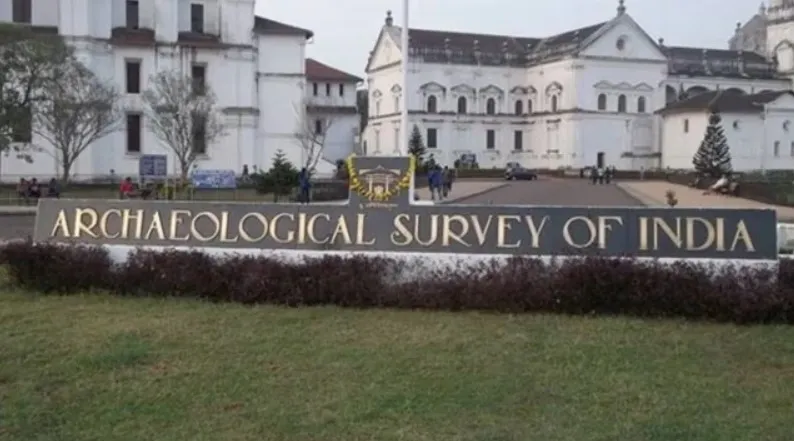By Swarati Sabhapandit
In India, archaeological practices and conservation are regulated by a network of bureaucratic mechanisms, legal authority, and disciplinary conventions. The primary institution at the helm of these practices is the Archaeological Survey of India.
Founded in 1861 by Alexander Cunningham, the ASI’s bureaucratic framework was firmly structured into a rigid hierarchical system by Mortimer Wheeler, who became its eighth Director-General in 1944. Wheeler consolidated an organisational structure, and meticulously oversaw the processing and classification of artefacts and the aesthetic display of excavated sites. Although post-colonial India retained ASI’s bureaucratic structure, the nature and composition of such hierarchy gradually changed over time.
Despite operating within a rigid bureaucratic framework, what sets ASI apart is the nature of its work, which is envisioned as a scientific endeavour focused on discovering, classifying, and characterizing archaeological sites within India’s historical narrative. Essentially, ASI was established as an epistemic institution dedicated to generating knowledge through scientific methodologies.
Ashish Avikunthak, in his robust ethnographic work, noted that in post-colonial India, the bureaucratic structure of the ASI exacerbated the institutional oppression that was endemic to it. His work identifies a narrative of systemic oppression in the form of arbitrary transfers, delayed promotions, exasperating work conditions, and inadequate infrastructure to produce quality work within the hierarchical structure of the ASI.
Avikunthak also alluded to the political contingencies both at the institutional and national levels that have affected the work of the ASI. The Ayodhya excavation project in 2003 solidified ASI’s role in shaping the national imagination, actively constructing and preserving a specific form of archaeological knowledge and heritage for the nation.
This epistemic goal was reinforced by the historic Ayodhya verdict, in which the Supreme Court heavily relied on a 2003 ASI report stating that the Babri Masjid was not constructed on vacant land but atop an underlying structure of similar size. Although ASI’s authority over sites has been contested in court cases since colonial times, the Ayodhya-Babri Masjid dispute was the first instance where archaeological knowledge was explicitly used to legitimize a political agenda. This monopolisation of knowledge was further reinforced by the judiciary, the political executive, and a majoritarian vision shaped by the idea of a Hindu State.
Since it assumed power at the centre in 2014, the Bharatiya Janata Party (BJP) took on the task of reclaiming the cultural heritage of Hindu civilization, asserting its suffering at the hands of ‘Islamic invaders’. Under the BJP’s watch, ASI has become a crucial component of this decolonising project. Although accusations of underfunding and ASI’s centralized, autocratic structure have intensified under the BJP government, the Ayodhya verdict and ASI’s subsequent involvement in the BJP’s temple politics are reshaping its perception in the popular narrative.
Today, the ASI serves a pivotal role in furthering Hindutva’s political agenda under the guise of ‘scientific methods.’ In this context, the Ayodhya verdict is instrumental in cementing ASI’s place in the public imagination of nation-building for two key reasons. One is the performative nature of the legal truth that has emerged from the courtrooms. Second, this was compounded by the Court’s uncritical reliance on the ASI report. Notably, while legal scholars and archaeology experts have pointed out several caveats, emphasizing the need for a more nuanced evaluation, the report itself does not provide concrete evidence identifying the structure as a temple dedicated to Lord Rama. However, during an excavation ordered by the Allahabad High Court, non-Islamic artifacts and figurines were discovered.
Historian Nayanjot Lahiri critically contends the Court’s handling of ASI in the Ayodhya dispute cases—as an unquestionable authority on historical knowledge—is fundamentally flawed from an archaeological research perspective. Moreover, this approach disregarded the credibility and expertise of other scholars, reflecting an intent to monopolize a specific narrative, which directly contradicts the core principles of scientific knowledge production. Beyond this, ASI’s role in the Ayodhya dispute indicates an interesting ideological trend, where excavations are carried out to provide an archaeological basis to validate Hindu religious texts.
Lahiri asserts that archaeological research, rooted in scientific principles, typically begins with a set of questions informed by specific methodological approaches. However, as with any field survey, excavations may not always yield answers to the initial inquiries but can instead uncover entirely different findings, which are equally valuable and intriguing. When excavation efforts become predominantly teleological—aiming to legitimize a particular historical narrative—they establish a hierarchical system of knowledge production, driven by political and ideological motivations. Under the BJP government, ASI’s epistemic focus has gradually shifted towards validating a revisionist historical agenda, ultimately aimed at reinforcing the vision of a Hindu State.
Another means by which the State advances its revisionist agenda is the distortion of historical narratives in school textbooks. While history has long been used as a tool to promote specific political objectives, these efforts have become increasingly crude in recent years. The State increasingly leverages ASI’s credibility to legitimize its political and ideological claims. This approach has not only prompted a rise in teleological research—framing particular sites through the lens of decolonization—but has also undermined ASI’s capacity to conduct independent and autonomous research.
A year after the consecration of the Ram Temple in Ayodhya, a wave of mosque-temple disputes have taken center stage, bringing renewed scrutiny to the constitutionality of the Places of Worship Act of 1991. In December 2024, the Supreme Court prohibited civil courts from registering new lawsuits challenging the ownership and title of places of worship or ordering surveys of disputed religious sites until further notice. Despite this, 11 major lawsuits remain pending across multiple locations in the country. A closer analysis of these ongoing legal battles reveals a strong correlation between the ‘disputed sites’ and states preparing for upcoming Assembly elections.
A more profound concern is how these developments seek to redefine the constitutional foundation of secular India. Additionally, the revisionist State’s ambition is reinforced by an alternative system of knowledge production, centred on reclaiming the ‘past glory’ of historical India. However, this reconstructed past is overwhelmingly shaped by a singular vision of India as a Hindu State, portrayed as having endured historical injustices inflicted by ‘Muslim others.’ To legitimize this reclamation project, the BJP has strategically positioned ASI as its key instrument.
In 1991, a lawsuit was filed on behalf of the Deity Adi Vishweshwar, claiming that the Gyanvapi Mosque in Varanasi, Uttar Pradesh, was constructed on the site of the Kashi Vishwanath temple. In 2021, five Hindu women petitioned at a Varanasi civil court, seeking permission to worship religious idols allegedly present inside the mosque. Subsequently, the Varanasi District Court ordered an archaeological survey of the Gyanvapi mosque complex. The ASI survey suggested the presence of a Hindu temple and submitted its findings to the court in a ‘sealed report’. Relying solely on the ASI’s conclusions, the court directed arrangements be made to facilitate worship in the basement of the Gyanvapi complex.
The Court’s blind reliance on ASI’s report as an exemplary source of historical knowledge deemed beyond challenge was questionable. While the Ayodhya verdict elevated the ASI’s prominence as an institution dedicated to restoring the Hindu State, it also revived the longstanding debate on the legitimacy conferred by political authority vis-a-vis the validity derived from its actions and accountability as a public institution. Moreover, when a complacent judicial institution approaches such matters with an uncritical predisposition, it effectively contributes to furthering a majoritarian agenda.
Historically, the judiciary’s role in religious matters has followed suit. Historically, the judiciary has taken a similar approach in religious matters. The courts’ fixation on the Essential Religious Practices (ERP) test reflects this pattern, as they have, at times, upheld majoritarian tendencies.
The test is prima facie problematic for two reasons: first, it is extremely arbitrary as it places the exclusive power to decide the integral religious matters on the judges with the help of religious practitioners and simultaneously erases agency from the individual. Second, the test has no constitutional basis and is against the norm of secularism. The Constitution discourages institutions of the State from interpreting any religious text to the extent that the decision entails choosing an integral part of any religion. Thus, instead of assessing multiple voices and their positionality, the test has legitimised dominant narratives in areas where the Court does not naturally possess the expertise to make constitutionally viable decisions. The judiciary’s exclusive reliance on ASI’s study fundamentally contradicts the principles of polyvocality. Moreover, elevating a single institution as the sole authority on historical knowledge— through a closely knitted web of the State, law, and ideological politics—ultimately contradicts the essence of scientific, evidence-based research.
Excavation continues to be underfunded in India. Although the DG oversees the allocation and management of ASI’s funds, the institution’s heavy dependence on government financial support limits its ability to function as an autonomous entity. Undoubtedly, reliance on the State is inevitable, given ASI’s role in the nation-building project of post-independent India. However, such dependency comes at a price, as research institutions like ASI risk becoming instruments for advancing the State’s political agenda.
Under the BJP government, ASI is not the only institution that has been gradually and systematically losing its autonomy. Central universities, courts, the Election Commission of India, and the Comptroller and Auditor General of India are among other autonomous bodies that have also been drawn into this trend. Given these circumstances, it is crucial to remove archaeology from the corridors of political power by granting it greater financial and decision-making independence to facilitate scientific, evidence-based research. Without such reforms, ASI’s pursuit of historical knowledge will remain confined within the narrow scope of the State’s revisionist agenda, limiting its ability to reclaim its true scholarly purpose. (IPA Service)
Courtesy: The Leaflet

 Pakistan Army Is In A Big Mess Over Handling The Crisis Of Hostages Taken By Baloch Liberation Forces
Pakistan Army Is In A Big Mess Over Handling The Crisis Of Hostages Taken By Baloch Liberation Forces 